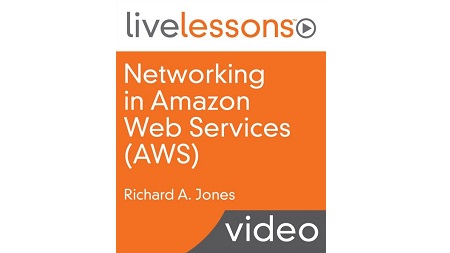
English | MP4 | AVC 1280×720 | AAC 44KHz 2ch | 3h 44m | 1.48 GB
Networking in Amazon Web Services (AWS) LiveLessons reviews key concepts related to networking, how those concepts apply to Amazon Virtual Private Cloud, and how networking enables high availability, fault tolerance, performance, and security. AWS Certified Solutions Architect Professional and AWS Authorized Instructor Richard A. Jones covers concepts and methods necessary to design and build secure networks within Amazon Web Services (AWS).
For applications running on EC2, the architecture begins with the network; in AWS, that is the Virtual Private Cloud or VPC. In order to gain the highest degree of security, resiliency, and performance, you need to design the network accordingly. In this series of videos from Richard A. Jones, you learn how network design can help leverage multiple availability zones and how the application of routing, network access control lists, and security groups contribute to security. You also see how to extend on-premises networks into AWS with VPN and Direct Connect, review how to achieve the best performance, and much more.
Gaining an in-depth understanding of the concepts unique to cloud computing is essential for being a valuable asset to any business leveraging AWS for their computing and storage needs.
Topics include:
- Networking Review
- Amazon VPC Part 1: Basics
- Amazon VPC Part 2: Advanced Concepts
- Network Security
- Connecting VPCs and On-Premises Networks
- Performance and Other Notes
Learn How To
- Leverage multiple availability zones via network design
- Contribute to security via application of routing, network access control lists, and security groups
- Extend on-premises networks into AWS with VPN and Direct Connect and achieve the best performance
Table of Contents
01 Networking in Amazon Web Services AWS LiveLessons – Introduction
02 1.0 Learning objectives
03 1.1 Review of IPv4
04 1.2 Review of IPv6
05 1.3 Classless Inter-Domain Routing (CIDR) Notation
06 1.4 Private Network Ranges
07 2.0 Learning objectives
08 2.1 Review of Amazon Virtual Private Cloud
09 2.2 Demo – Creating a VPC
10 2.3 Subnets
11 2.4 Demo – Creating Subnets
12 2.5 Routing
13 2.6 Internet Access
14 2.7 Public IPv4 Address Assignment
15 2.8 IPv6 Address Assignment
16 2.9 Amazon IP Ranges
17 2.10 Demo – Enabling Internet Access
18 3.0 Learning objectives
19 3.1 Hybrid Subnets with Network Address Translation (NAT)
20 3.2 Demo – Creating a NAT Gateway
21 3.3 Egress-Only Internet Gateway
22 3.4 Third-Party Network Appliances
23 3.5 VPC Endpoints
24 3.6 Demo – Creating a VPC Endpoint
25 4.0 Learning objectives
26 4.1 Security in Layers
27 4.2 Routing as Security
28 4.3 Network Access Control Lists (NACLs)
29 4.4 Demo – Creating NACLs
30 4.5 Security Groups
31 4.6 Demo – Creating Security Groups
32 5.0 Learning objectives
33 5.1 VPC Peering
34 5.2 VPC Peering Scenarios
35 5.3 Demo – Peering two VPCs
36 5.4 VPN Overview
37 5.5 AWS Hardware VPN
38 5.6 Demo – Creating an AWS Hardware VPN
39 5.7 AWS VPN CloudHub
40 5.8 Software VPN
41 5.9 AWS Direct Connect
42 6.0 Learning objectives
43 6.1 Default VPC
44 6.2 Elastic Network Interface (ENI)
45 6.3 Enhanced Networking
46 6.4 Jumbo Frames
47 6.5 Placement Groups
48 6.6 DHCP Options
49 Networking in Amazon Web Services AWS LiveLessons – Summary
Resolve the captcha to access the links!